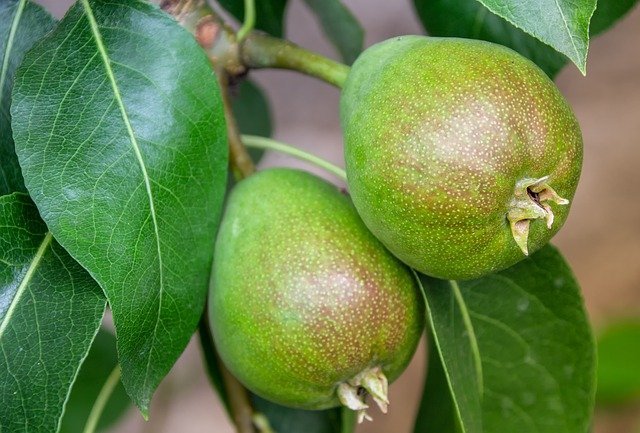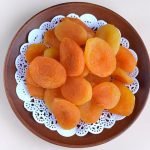
Pears are simple but excellent fruits not only for our palate, but also for our physical well-being and are practically suitable for everyone. Let’s see why they are good.
The pear is the fruit of the Pyrus communis plant, belonging to the large Rosaceae family, which also includes apples, peaches, apricots, plums, cherries and almonds.
There are many varieties of pears and it is possible to find them in the markets practically all year round, even if the typical season is autumn. Pear is a very sweet fruit, very versatile in the kitchen and practically suitable for everyone, in fact it is often one of the first fruits we taste from an early age.
Pears: varieties and characteristics
There seem to be up to 30 different varieties of pears, all very good and with very similar nutritional properties, but with some peculiarities that differentiate them. Let’s see some of the best known and most popular.
- Pera Abate: this variety owes its name to the person who selected it in the fifteenth century, an abbot in a French convent. It is an autumn variety, with an elongated shape, with a green skin with reddish hues that is widely cultivated in Italy, especially in Emilia Romagna. It is sweet and crunchy, excellent to eat on its own;
- Williams pear: the Williams pear is one of the most widespread and cultivated in Italy, especially in the north. It has a slightly elongated shape, usually smaller than the Abbot, with a white and juicy pulp, which also adapts well to cooking. It is a summer variety, which can be found from August throughout the autumn;
- Kaiser pear: it is possible to find this pear from August until the whole winter and part of the following spring. Its color is typically brown, with shades ranging from ocher to dark brown, slightly elongated in shape and medium-large in size. The flavor is very intense;
- Pear Coscia: these pears are light green in color, usually small in size, with white and grainy pulp, which ripen in summer;
- Decana pear: the Decana pear is considered a valuable variety, suitable for fresh consumption. It has a rather rounded shape, with a sweet and juicy pulp, it can be enjoyed from summer to late winter;
- Guyot pear: it is a summer pear, it can be tasted in July and August. It is medium-sized, light green in color, with a slightly grainy pulp;
- Nashi pear: the Nashi pear is a pear of Asian origin, has a round shape, a thin stalk, is yellow in color and has a crunchy and juicy pulp. It is best enjoyed in the warm months.
Pears: calories and nutritional values
Pears are sweet and juicy fruits, particularly rich in water, which also mitigates their caloric intake , which is approximately 35 kcal per 100 grams. Therefore, a medium-sized pear (about 150 grams) provides just over 50 kcal and can also be consumed in the context of low- calorie diets.
Pears contain sugars, mainly in the form of fructose, but also fibers, which lowers their glycemic index, which is equal to 30. For this reason, they can also be included in the diet of diabetic subjects.
Pears are rich in both soluble and insoluble fiber, both essential in our diet as they accelerate intestinal transit, prevent constipation, increase the sense of satiety, reduce the absorption of simple sugars and fats (especially cholesterol) and improve glycemic control. The consumption of a single pear allows us to take almost 1/5 of our daily fiber requirement, which corresponds to 25-30 g, but about half are contained in the peel, for this reason it is not advisable to peel the pears, we would eliminate an extraordinary amount of items. An example of a particularly abundant soluble fiber in pears is pectin, useful in improving digestion,lower blood cholesterol levels and lower blood sugar.
There are also vitamins and minerals, such as vitamin C, vitamin K, potassium, copper, magnesium and some B vitamins.
The peel of pears contains not only fibers but also molecules with an antioxidant action, flavonoids. The most represented are:
- Chlorogenic acid: polyphenolic compound famous for being particularly present in green coffee. It is associated with the reduction of blood pressure;
- Epicatechin: flavonoid with antioxidant action capable of reducing inflammatory levels and cardiovascular risks;
- Cyanidin: flavonoid useful in protecting the body from oxidative stress and cardiovascular damage;
- Quercetin: has anti-inflammatory and anti-bacterial action.
Therefore, these are fruits that are not only excellent to taste, but also beneficial for our health. Let’s see the nutritional values in detail.
Nutritional values for 100 gr of pears:
- Kcal: 35
- Proteins: 0.3g
- Carbohydrates: 8.8 g
- Fat: 0.1 g
- Waterfall: 87.4 g
- Fiber: 3.8 g
- Soccer: 11 mg
- Potassium: 127 mg
- Magnesium: 7 mg
- Phosphorus: 15 mg
- Zinc: 0.05 mg
- C vitamin: 4 mg
- Vitamin B1: 0.01 mg
- Vitamin B2: 0.03 mg
- Vitamin B3: 0.10 mg
- Vitamin B5: 0.07 mg
- Vitamin B6: 0.02 mg
- Vitamin K: 3.6 mg
Pears: properties and health benefits
Pear is a very good fruit, loved by everyone and also extremely healthy, because thanks to the combination of macro and micronutrients it contains, it is good for the cardiovascular system, bones, gastro-intestinal system, the immune system and even the skin. , giving it tone and elasticity. Let’s now see the main benefits of pears.
✓ Ally of the intestine
The numerous fibers that the pear contains, both in the peel and in the pulp, make it a great ally of our intestine, fighting constipation and regulating intestinal functions, also contributing, thanks to the soluble fibers, to the correct absorption of all. the nutrients introduced with food.
✓ Rich in antioxidants
Pear is rich in antioxidant compounds, in particular polyphenols and flavonoids, which slow down cellular aging and help keep our cells healthy by protecting them from inflammatory damage.
✓ Suitable for diabetes
Although the pear contains enough sugar, it has a low glycemic index and therefore can also be consumed by those suffering from diabetes, helping with the fibers to regulate the level of sugar in the blood. In this case it is still advisable to consume less ripe pears, naturally lower in sugar.
✓ Contrasts hypertension
Potassium, together with the antioxidant compounds and fibers contained in pears, contributes to the general well-being of the cardiovascular system and in particular counteracts hypertension as it helps to maintain normal blood pressure values.
✓ Nutrition of athletes
Thanks not only to the minerals it contains, but also to the sugars and water, it is a very useful resource to replenish the fluids and energy spent during physical activity, for this reason it is well suited to be included in the diet of athletes.
✓ Promotes diuresis
The pear is particularly rich in minerals, such as iron, sodium, calcium, potassium, which together with the water that this fruit contains in abundance, help maintain the hydrosaline balance of our body and promote the elimination of waste. In addition to pears, there are numerous other foods and plants with a draining power. For further information we invite you to read: Natural diuretics: 10 remedies that promote diuresis.
✓ Suitable for all ages
The pear is an excellent source of vitamins (including folate), minerals, fiber, carbohydrates even during pregnancy and breastfeeding, as well as in children, so much so that the pear is one of the first fruits introduced during weaning, and even in old age.
✓ Support for the immune system
Pear contains a good amount of vitamin C, a vitamin with known antioxidant properties that contributes to the proper functioning of our immune system and counteracts the formation of free radicals. Furthermore, it is extremely rich in flavonoids, anthocyanins and catechins which give the fruit excellent anti- inflammatory properties.
✓ Satisfying effect
Consuming a pear during a snack away from meals will not only give our palate a sensation of sweetness, but it will also give us a sense of satiety due to the fiber and water that this fruit contains, and will fill our desire for sweet. This effect is also useful in the context of a weight loss diet, in which the pear can be inserted without problems.
✓ Friend of the skin
Pear extract is traditionally used as a beauty product for the skin, which, in the form of emulgel, is able to restore tone and elasticity.
Raw pears and cooked pears: nutritional differences and which ones to choose
It is well known that fresh fruit should never be missing in our daily diet and we usually choose raw fruit both for a greater speed of preparation and to preserve all the organoleptic and nutritional characteristics. Pears are fruits that are well suited to be consumed even cooked. There are some nutritional characteristics that are lost with cooking and others that are enhanced:
- Cooked pears: cooked pears are more easily digestible and have a greater laxative power than raw ones. Furthermore, the greater softness given by cooking makes them suitable also for those who have problems in chewing and swallowing. Eating cooked pears can also be a way to substitute a spoon dessert, certainly healthier than a pastry dessert, but equally tasty;
- Raw pears: on the other hand, raw pears keep intact the vitamins and antioxidant compounds that are degraded during cooking and also have a lower glycemic index than cooked ones because in cooking, losing part of their water, pears concentrate more the sugars they contain.
As a daily habit, in order to benefit from all the properties of pears, it would therefore be advisable to eat them raw, reserving the consumption of cooked ones for some occasions.
How many pears to eat
As already mentioned, the pear is not a very caloric fruit and can be consumed by practically everyone. In a healthy and balanced diet, it would be good to eat two or three portions of fruit a day, so if we like pears, we could also eat a couple a day, taking into account that a portion of pear is equal to 150 – 200 g, which is the weight of a pear of average size, which will therefore provide about 50 to 70 kcal. To avoid a laxative effect, however, it will be good to alternate pears with other fresh seasonal fruits.
How to choose pears
Pears are in season practically all year round. Depending on the period, in fact, different varieties of pear will be available. When choosing the fruit, check its degree of ripeness by touching it lightly: if it is firm it is a more unripe fruit while, if it is softer, the fruit will be ripe. Like any other fruit, the riper the pear, the sweeter it will be. Also, it is good to check that there are no dark spots on the skin.
Once purchased, pears can be stored in the refrigerator (in the lower part) during the hot season and out of the fridge if the period is cold. To accelerate their ripening, they can be placed next to ripe apples. As we have said, the pear should be consumed with the peel , to avoid the loss of precious fibers. This is why it is important to choose organic fruits .
How to use pears
Pears are very versatile fruits in the kitchen. It being understood that the best and simplest way to enjoy them is raw for breakfast, as a snack, we can use them in various ways: cooked in the oven or in the microwave, they can replace a dessert or a winter snack; as we have seen above, it is better to eat the peel as well, to benefit from the fiber and flavonoids it contains. You can use them raw in fruit salads and smoothies or combine them with cheeses for special second courses. In this regard, some cheeses that go well with pears or pear jam are pecorino, gorgonzola, taleggio, provolone or asiago.
To consume more pears we can also resort to the use of thirst-quenching and nourishing extracts. Try, for example, to combine 2 pears with a piece of fresh ginger and the juice of 1/3 of a lemon, you will get a very good and very nutritious extract.
Of course you can make delicious pear jams, excellent for filling strudel or pies or a slice of bread for breakfast or simply by cutting them into slices you can fill a tart. Let’s not forget the combination of pears and chocolate that we find in some desserts.
If we are greedy and want to preserve pears, a great way to do it is to prepare pears in syrup, which however will not be allies of our line since their preparation involves the use of sugar, so in this case it will be good to consume them sparingly.
Quince: what it is and what it is good for
The quince pear is a fruit of Asian origin typical of the autumn and winter season. It has a rather hard and lumpy texture, its skin is yellow and the shape is that of a pear a little more rounded than usual. Like quince, quince pear also has a fairly sour taste, so much so that it is usually eaten cooked, especially to prepare jams and jellies. The sour taste is due to the abundance of tannins, antioxidant phenolic compounds useful for our health.
Like the traditional pear, it has a good content of vitamin C and B vitamins, all compounds that deteriorate with cooking. However, the mineral and fiber content remains high even during cooking, both of which are rich in the skin and the pulp, it is in fact advisable, especially if eaten cooked, to also eat the peel.
The fiber content is in fact higher than normal pears and therefore they are very useful both for the health of the colon and for the modulation of the absorption of fats and sugars, therefore particularly suitable for those suffering from diabetes or dyslipidemia and in general for those who want to benefit from it to protect the cardiovascular system.
Pears: contraindications
As already mentioned, pears are fruits suitable for practically everyone because they have no major contraindications, apart from the fact that they can cause diarrhea if used in large quantities. Also containing FODMAPs, or short-chain carbohydrates, they could cause belly bloating due to gas formation and abdominal cramps. For this reason, those suffering from irritable bowel syndrome are advised to reduce the consumption of this fruit.
Of course, anyone with a specific allergy to this fruit must refrain from consuming them. Pears are not a highly allergenic fruit, however there have been documented cases of oral allergic syndrome, which causes problems in the mouth and throat especially in subjects allergic to birch pollen. In addition, pears contain nickel, which should be taken into consideration if you have an allergy to this metal.






